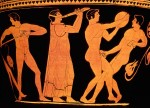
National Geographic talked with Tony Perrotet, author of
The Naked Olympics: The True Story of the Ancient Games about how the ancient Olympics compares with the modern version.
The Olympic Games were held every four years from 776
B.C. to A.D. 394, making them the longest-running recurring event in
antiquity. What was the secret of the games’ longevity?
It was the sheer spectacle of it. Sports [were] one part of a grand,
all-consuming extravaganza. It was first and foremost a religious event,
held on the most sacred spot in the ancient world. It had this
incredible aura of tradition and sanctity.
Today’s Olympics is a vast, secular event, but it doesn’t have the
religious element of the ancient Olympics, where sacrifices and rituals
would take up as much time as the sports. And there were all these
pecripheral things that came with the festival: the artistic happenings,
new writers, new painters, new sculptors. There were fire-eaters, palm
readers, and prostitutes.
This was the total pagan entertainment package.
Perrotet elaborates on all those things in the rest of the interview at
NatGeo.
 National Geographic talked with Tony Perrotet, author of The Naked Olympics: The True Story of the Ancient Games about how the ancient Olympics compares with the modern version.
National Geographic talked with Tony Perrotet, author of The Naked Olympics: The True Story of the Ancient Games about how the ancient Olympics compares with the modern version.
No comments:
Post a Comment